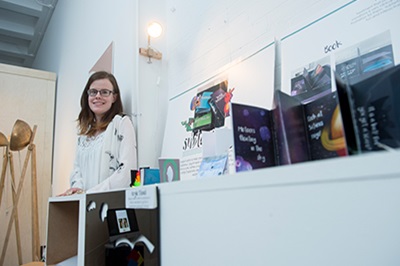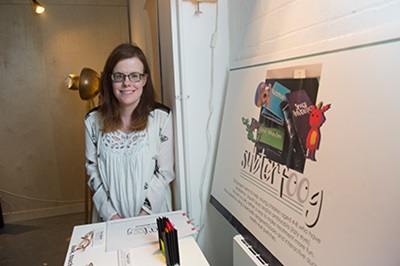Courtney Morrison has designed a therapy book for children affected by the vision development disorder in an effort to encourage them to step up their rehabilitation through the medium of play.

The three illustrated pop-up books – which are one of hundreds of exhibits created by students to be showcased at Edinburgh Napier’s More Than A Degree Show from 19 May - feature stories in environments where vision would be difficult – underwater, in space and in a cave – and come to life in a fun and playful way when opened.
The books are complemented by augmented reality, with Courtney mixing old and new by designing an app that reacts with an eye patch to bring the stories to life.
Eye patches are commonly worn by those affected by the disorder to encourage use of the affected eye. The app reacts when it recognises the presence of a specific pattern on the patch itself to produce 3D visuals that children can engage with and enjoy.
A lazy eye is common in infancy and early childhood and results in an eye failing to achieve the normal visual acuity, even when prescription glasses or contact lenses are used. It can be corrected using a number of treatments including the use of proper glasses, an eye patch to encourage a child to use the affected eye and in some cases surgery.
Courtney, who is in her final year of a design and digital arts course at Edinburgh Napier, was herself affected by the disorder in her younger years and was inspired to produce the book and eye patch technology after struggling with her own treatment that was prescribed. She even returned to her old primary school in Alness to road test her approach.
She said: “I received various treatments when I was younger to try and help my affected eye. I was encouraged to wear an eye patch and carry out tasks with small objects to increase the depth of field in the eye.
“I found my treatment didn’t really help and I believe that having access to new technology such as augmented reality would made the whole process a bit more fun and friendlier.

“I’ve designed what I think is a more playful and inviting therapy book that is actually inclusive for all. It’s hard for a child to think they are different from anyone else so the fact that anyone can read it or use the eye patch was a key consideration for the entire project.
“The workshop with youngsters at Obsdale Primary School in Alness was a massive aid in helping me ensure my design will be fun and enjoyable for those who will hopefully use it on a daily basis. If I can learn from my own experiences and help others with their own treatment in the future, then it will have been a worthwhile project.”